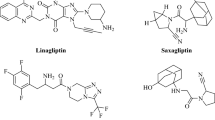Abstract
Dipeptidyl peptidase IV (DPP-IV) is a potential drug target for type-2 diabetes and DPP-IV inhibitors are known to efficiently improve glucose tolerance. In the present study, pharmacophore model for a set of 29 DPP-IV inhibitors was generated by ligand-based pharmacophore generation process. The best hypothesis, hypo 1, consisting of four chemical features, namely, one hydrogen bond donor, one hydrogen bond acceptor, one hydrophobe and one ring aromatic was validated by cost function analysis, test set prediction and Fischer test. The validated pharmacophore model was then used for searching new lead compounds from Maybridge and NCI database. Four compounds (CD01797, CD06202, CD02493, and AW01077) from Maybridge database and three compounds (NSC997, NSC2450, and NSC5815) from NCI database were identified as structurally diverse druggable novel leads with nM activity against DPP-IV.














Similar content being viewed by others
References
Ahren B, Holst JJ, Martensson H, Balkan B (2000) Improved glucose tolerance and insulin secretion by inhibition of dipeptidyl peptidase IV. Eur J Pharmacol 404:239–245
Balkan B, Kwasnik L, Miserendino R, Holst JJ, Li X (1999) Inhibition of dipeptidyl peptidase IV with NVP-DPP728 increases plasma GLP-1 (7-36 amide) concentrations and improves oral glucose tolerance in obese Zucker rats. Diabetologia 42:1324–1331
Brooks BR, Bruccoleri RE, Olafson BD, States DJ, Swaminathan S, Karplus M (1983) CHARMM: a program for macromolecular energy, minimization, and dynamics calculations. J Comput Chem 4:187–217
Deacon CF, Hughes TE, Holst JJ (1998) Dipeptidyl peptidase IV inhibition potentiates the insulinotropic effect of glucagon like peptide 1 in the anesthetized pig. Diabetes 47:764–769
Holst JJ (1994) Glucagon-like peptide-1 (GLP-1) a newly discovered GI hormone. Gastroenterology 107:1048–1055
Holst JJ, Deacon CF (1998) Inhibition of the activity of dipeptidyl-peptidase IV as a treatment for type 2 diabetes. Diabetes 47:1663–1670
Jacotot E, Callebaut C, Blanco J, Krust B, Neubert K, Barth A, Hovanessian AG (1996) Dipeptidyl-peptidase IV-B, a novel form of cell-surface-expressed protein with dipeptidyl-peptidase IV activity. Eur J Biochem 239:248–258
Marguet D, Baggio L, Kobayashi T, Bernard AM, Pierres M, Nielsen PF, Ribel U, Wantanabe T, Drucker DJ, Wagtmann N (2000) Enhanced insulin secretion and improved glucose tolerance in mice lacking CD26. Proc Natl Acad Sci USA 97:6864–6879
Mentlein R (1999) Dipeptidyl-peptidase IV (CD26)-role in the inactivation of regulatory peptides. Regul Pept 85:9–24
Mentlein R, Gallwitz B, Schmidt WE (1993) Dipeptidylpeptidase IV hydrolyzes gastric inhibitory polypeptide, glucagon like peptide-1 (7-36), peptide histidine methionine and is responsible for their degradation in human serum. Eur J Biochem 214:829–835
Paliwal S, Pal M, Yadav D, Singh S, Yadav R (2011) Ligand-based drug design studies using predictive pharmacophore model generation on 4H-1,2,4-triazoles as AT1 receptor antagonists. Med Chem Res. doi:10.1007/s00044-011-9756-4
Pederson RP, White HA, Schlenzig D, Pauly RP, McIntosh CRP, Demuth HU (1998) Improved glucose tolerance in Zucker fatty rats by oral administration of the dipeptidyl peptidase IV inhibitor isoleucine thiazolidide. Diabetes 47:1253–1258
Rachman J, Borrow BA, Levy JC, Turner RC (1997) Near normalisation of diurnal glucose concentrations by continuous administration of glucagon-like peptide 1 (GLP-1) in subjects with NIDDM. Diabetologia 40:205–211
Wettergren A, Schjoldager B, Martensen PE, Myhre J, Christiansen J, Holst JJ (1993) Truncated GLP-1 (proglucagon 72-107 amide) inhibits gastric and pancreatic functions in man. Dig Dis Sci 38:665–673
Yaron A, Nadier F (1993) Proline-dependent structural and biological properties of peptides and proteins. Crit Rev Biochem Mol Biol 28:31–81
Zhonghua P, Xiaofeng L, Kenton L, Thomas WG, Paul EW, Thomas HL, Bradley AZ, Kent S, Stephen JB, Michael AS, Amanda KM, David WAB, Michelle L, Heidi W, Anita JKG, David JM, Todd SM, Lakshmi B, Michael GF, Daisy P, Larry RS, Marc RL, Rohinton E, Elizabeth HF, Hing LS, James MT (2006) Discovery, structure-activity relationship, and pharmacological evaluation of (5-substituted-pyrrolidinyl-2-carbonyl)-2-cyanopyrrolidines as potent dipeptidyl peptidase IV inhibitors. J Med Chem 49:3520–3535
Acknowledgment
Computational resources were provided by Banasthali University, and the authors thank the Vice Chancellor, for extending the necessary facilities.
Conflict of interest
The authors have no conflicts of interest.
Author information
Authors and Affiliations
Corresponding author
Rights and permissions
About this article
Cite this article
Sharma, J., Yadav, D. & Paliwal, S. Discovery of novel DPP IV inhibitors: application of pharmacophore-based virtual screening. Med Chem Res 22, 558–572 (2013). https://doi.org/10.1007/s00044-012-0044-8
Received:
Accepted:
Published:
Issue Date:
DOI: https://doi.org/10.1007/s00044-012-0044-8




